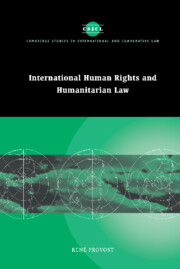Book contents
Introduction
Published online by Cambridge University Press: 07 September 2009
Summary
Armed conflict and massive violations of fundamental human rights continue to elude the efforts of the international community to prevent them. The shortcomings of international law are more strikingly illustrated with every crisis. Even genocide, the most intolerable assault on humanity, so far has proven impossible to stamp out. To most people, and probably to most jurists, international law appears not merely ill-equipped but broadly impotent in its ability to provide concrete solutions to these blatant violations. While international lawyers may not subscribe completely to this assessment, a real unease must accompany an analysis of theoretical constructs which are supposed to provide solutions to these intractable problems. Clearly, human rights and humanitarian law do not offer easy answers as to how to prevent infringements of the basic dignity and integrity of all people in times of war and peace. They represent rational attempts to articulate standards which ideally will become universally accepted and guide the international community in its evaluation of, and reaction to, such violations.
The international community has succeeded in building a consensus on a large number of standards in the fields of human rights and humanitarian law. We now have a thick code of rules at our disposal, although it clearly does not address every situation nor cover every region. Those rules will be called upon to evolve as the challenges facing the international community take on new shapes.
- Type
- Chapter
- Information
- International Human Rights and Humanitarian Law , pp. 1 - 10Publisher: Cambridge University PressPrint publication year: 2002

